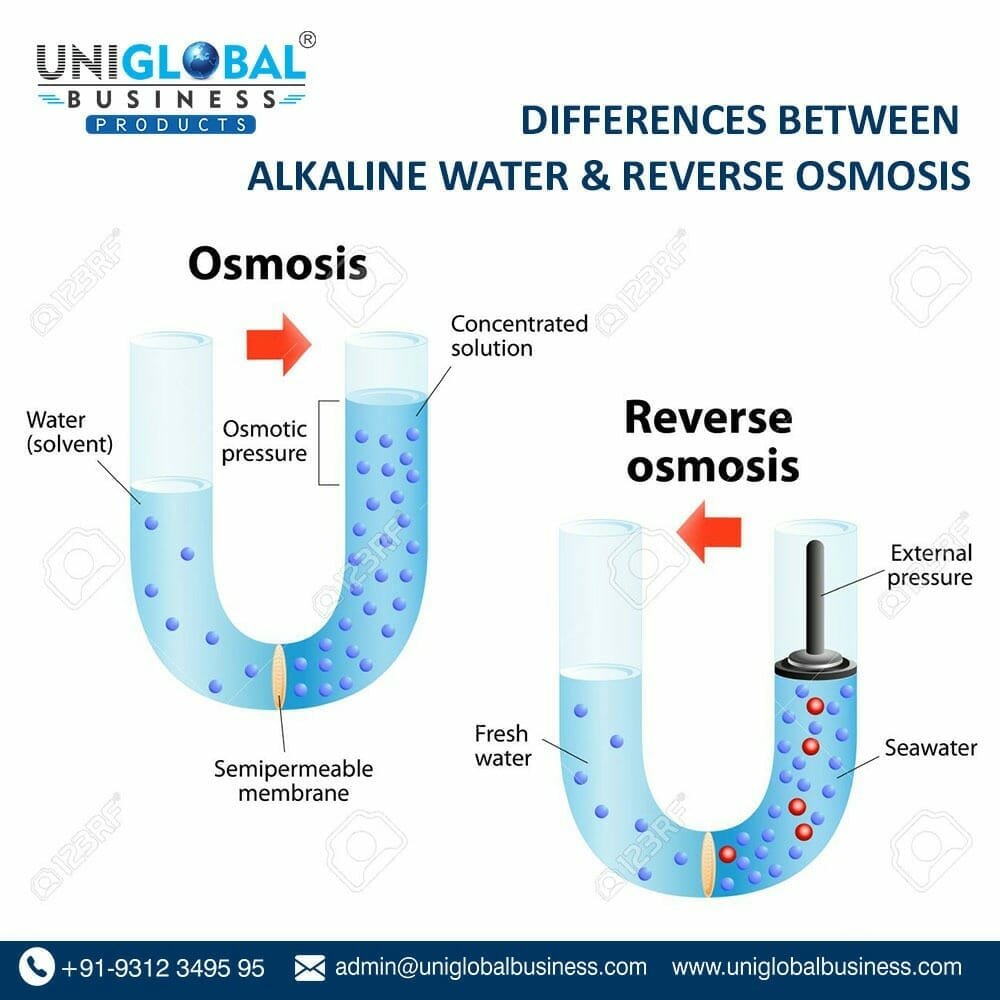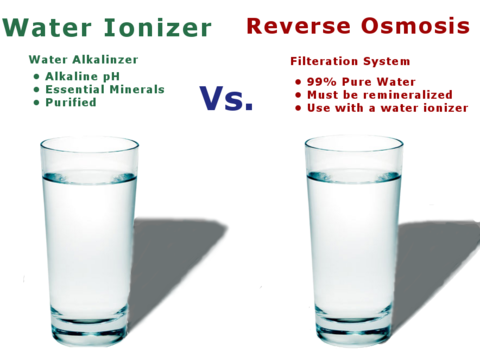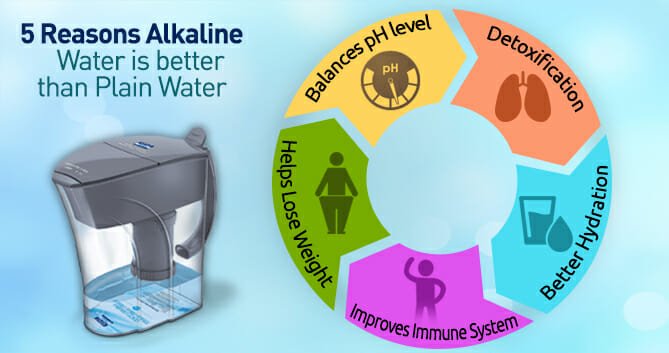

The differences between alkaline water and reverse osmosis are likely complex. This could be because people frequently link alkaline water with ioniser devices, which isn’t necessarily the case. We’re talking about countertop alkaline water filters that don’t cost a fortune or use a lot of electricity. For decades, people have believed that alkaline water is beneficial to their health. However, current marketing positions the same beverage as a performance-enhancing sports drink that costs at least twice as much as bottled water. Here’s everything you need to know about the differences between Alkaline water and Reverse Osmosis.
What is Reverse Osmosis (RO) and how does it work?
To remove ions, particles, and molecules from water, reverse osmosis employs a semipermeable membrane device. Filtration to a micron size of 0.0001 is possible with this type of water filtration technology. This is accomplished by forcing water through the device and separating the molecules using hydraulic pressure, which necessitates the use of electricity.

Reverse osmosis (RO) is a water treatment method that eliminates impurities from water by forcing water molecules through a semipermeable membrane under high pressure. Contaminants are filtered and eliminated during this procedure, leaving clean and tasty drinking water.
Reverse Osmosis produces ultra-pure drinking water that is ideal for daily use. The highly sophisticated RO method eliminates pollutants from water down to a millionth of a micron. A human hair is 3-5 microns in diameter as a point of comparison.
Hundreds of thousands of contaminants are removed using Reverse Osmosis Technology, including chlorine, fluoride, prescription medicines, excess minerals, heavy metals, microplastics, and unregulated or emergent contaminants (chemicals and compounds not yet controlled by the EPA).

The Dangers of Drinking RO Water
● Although a RO water purifier removes dissolved contaminants, it also removes natural minerals like iron, magnesium, calcium, and sodium, which are necessary for human health and can lead to a mineral shortage.
● The bacteria and viruses that cause waterborne illnesses are not killed by the RO water filter. Microorganisms have a greater chance of getting into the RO membrane.
What is Alkaline water?
The pH of alkaline water is 9.5 or higher. The theory behind drinking alkaline water is straightforward: acidity accumulates in our bodies in a variety of ways, and it must be balanced out. Pollution from the environment, a poor diet, and a stressful lifestyle can all contribute to acidity in the body. In our modern environment, stressors abound and require ongoing thoughtful control; else, they will get the best of us in some way.
The minerals in alkaline water are easily absorbed by the body, and their alkalinity aids in pH balance. Alkaline water boosts your body’s calcium uptake, according to studies on its health effects. Milk is an acid-forming substance in the body, thus it may cause more harm than good, according to several health experts. Alkaline water is thought to be just as helpful as milk for dietary calcium.
● Hydrogen that is alkaline Water has been ionised, which means the pH level of the water has been raised.
● A pH level is a number that, on a scale of 0 to 14, indicates how acidic or alkaline a substance is. For example, a score of 1 indicates that the chemical is extremely acidic, whereas a number of 13 indicates that it is extremely alkaline.
● Alkaline ionised water contains four beneficial minerals, including Calcium, Magnesium, Sodium, Potassium, and others, making it safe to drink.
● A natural water ioniser turns RO water into antioxidant alkaline hydrogen water, which has the potential to benefit millions of people’s health. It’s chemical-free and enriched with natural minerals.
Benefits of Alkaline water

Many claims have been made about the health benefits of drinking alkaline ionised water, alkaline hydrogen water, or Kangen Water, including:
● A more powerful immune system
● Controlling Your Weight
● Cancer prevention
● pH levels in the body that are in balance
● Higher levels of energy
● Acid reflux symptoms are lessened.
Alkaline Water vs. Reverse Osmosis: What’s the Difference?
1. Alkaline Water filtration does not necessitate the use of energy.
Reverse osmosis, as previously mentioned, requires electricity to produce the hydraulic pressure required to cleanse the water and eliminate particles as fine as a micron. This, along with the relatively high cost of a reverse osmosis system, makes alkaline water a far more financially realistic option. A countertop filter is typically considerably easier to install than a reverse osmosis system.
2. Minerals are removed via reverse osmosis.
Despite the fact that RO eliminates particles down to 0.0001 microns, it does not always result in the cleanest water. The RO method decreases the total dissolved solids count to zero, but it also removes the mineral content of the water, as well as all other impurities. If your mineral intake from your diet is insufficient, demineralized water is not suggested for long-term human consumption since it might induce dilution and inadequacies. To get around this, the system would have to remineralize the water, which would be an additional stage in the process.
An alkaline water filter, on the other hand, can increase the mineral content of drinking water while also adding electrolytes to help with hydration. This supplement helps with mineral absorption from your diet and might provide a much-needed boost if you don’t obtain enough minerals from meals. Because your body absorbs minerals more quickly from water than from food, alkaline water is an excellent approach to maintain mineral and electrolyte balance.
3.The process of reverse osmosis wastes a lot of water.
Back pressure is formed as a reverse osmosis system forces more water through its system, resulting in more water being wasted. Because of the high pressure required by RO to remove all dissolved solids, a large amount of wastewater is produced, which carries all of the removed particles.
Retention rates vary depending on the manufacturer and model, but they can be as low as 20%. This means that if you filter 20 litres of reverse osmosis water, you’ll flush about 80 gallons down the toilet! While some new technologies claim to have achieved zero-waste systems, they are usually quite costly..

4.The size of an alkaline water filter isn’t enormous.
As you might expect, reverse osmosis systems are enormous appliances that take up a lot of room in your kitchen. Because it comes in the form of a little jug, an alkaline water filter may fit in your fridge. They can also be rather costly, which means that an alkaline water filter is a far more cost-effective option in terms of both aesthetics and economics.
5.The process of reverse osmosis causes water to become acidic.
In contrast to RO water, which makes your drinking water more acidic, alkaline water raises the pH level of your drinking water. As previously stated, RO eliminates all minerals, yet this has a negative impact on the pH level. To raise the pH and give RO water a healthy mineral content, it must be passed through an ioniser machine, which takes additional time and money.
6.pH level
With a PH of 7, reverse osmosis water is practically clean. Reverse osmosis is a water filtration technology that removes over 99 percent of all pollutants. The end product is nearly pure water with a pH of 7. When exposed to air, however, RO water becomes acidic, with a pH range of 5–5.5. Pure water is a voracious eater. It literally snatches CO2 from the air! A glass of pure RO water can decline from a pH of 7 to 5.5 or below in about an hour, resulting in acidic water. Reverse osmosis water does not have a pH of greater than 7, hence it is not alkaline water.
7.In terms of health, Alkaline Water is more healthier than Reverse Osmosis
Alkaline water is far healthier than RO water since there was no RO water in the past, and people were a lot healthier than they are now because most of them drink RO water, which is devoid of minerals. Alkaline water is one sort of water that is not only good for thirst but also for immunity. RO water is a business model that was developed to be a viable way to make money.
Conclusion :
The reverse osmosis technique makes your water slightly acidic by filtering alkaline minerals. This is very typical and occurs with all forms of filtration. The rise in acidity is negligible and has no effect on your health. Regardless of what you eat, your body maintains a stable internal pH level.
Unlike reverse osmosis water, which makes water more acidic, alkaline water raises the pH level of your drinking water. As previously stated, RO removes all minerals, which has a negative impact on the body’s pH level.
You must switch to alkaline water to raise the pH and give your reverse osmosis water a healthy mineral content. To receive it, you’ll need to go through an ionising machine, which will take a long time and cost a lot of money. Natural calcium, magnesium, tourmaline balls, and other alkaline minerals are found in alkaline ionised water and alkaline hydrogen water sticks, which help to eliminate chlorine and other negative ions.
